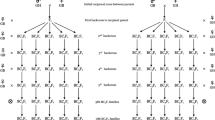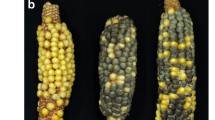Abstract
Pollen-mediated movement of transgenes from transplastomic oilseed rape (Brassica napus) into wild relatives will be avoided if chloroplasts are maternally transmitted. We assess the probability of chloroplast exchange between conventional oilseed rape and wild Brassica rapa to model the future behavior of transplastomic cultivars. Primers specific to cpDNA were used to demonstrate maternal inheritance of chloroplasts in 47 natural hybrids between cultivated B. napus and wild B. rapa. We conclude that there will be no or negligible pollen-mediated chloroplast dispersal from oilseed rape. Transgene introgression could still occur in mixed populations, however, if B. napus acted as the recurrent female parent. Rate of transfer would then depend on the abundance of mixed populations, their persistence as mixtures, and hybridization frequency within stands. A low incidence of sympatry (0.6–0.7%) between wild B. rapa and cultivated B. napus along the river Thames, UK, in 1997 and 1998, suggests mixed stands will form only rarely. Eighteen feral populations of B. napus also showed a strong tendency toward rapid decline in plant number, seed return, and ultimately, extinction within 3 years. Conversely, hybrid production is significant in mixed stands, and the absence of control practices means that oilseed rape will have slightly greater persistence. We infer that some introgression from transplastomic B. napus into B. rapa is inevitable in mixed populations even though such populations will occur infrequently and will tend to lose B. napus plants relatively quickly. Chloroplast exchange will be extremely rare and scattered.
This is a preview of subscription content, access via your institution
Access options
Subscribe to this journal
Receive 12 print issues and online access
$209.00 per year
only $17.42 per issue
Buy this article
- Purchase on Springer Link
- Instant access to full article PDF
Prices may be subject to local taxes which are calculated during checkout

Similar content being viewed by others
References
Daniell, H., Datta, R., Varma, S., Gray, S. & Lee, S.-B. Containment of herbicide resistance through genetic engineering of the chloroplast genome. Nat. Biotechnol. 16, 345–348 (1998).
Gray, A.J. & Raybould, A.F. Reducing transgene escape routes. Nature 392, 653–654 (1998).
Cummins, J.E. Chloroplast-transgenic plants are not a gene flow panacea. Nat. Biotechnol. 16, 401 (1998).
Stewart, C.N., Jr. & Prakash, C.S. Chloroplast-transgenic plants are not a gene flow panacea. Nat. Biotechnol. 16, 401 (1998).
Robert, S. & Baumann, U. Resistance to the herbicide glyphosate. Nature 395, 25–26 (1998).
Daniell, H. & Varma, S. Chloroplast-transgenic plants: Panacea–No! Gene containment–Yes! Nat. Biotechnol. 16, 602 (1998).
Corriveau, J.L. & Coleman, A.W. Rapid screening method to detect potential biparental inheritance of plasmid DNA and results for over 200 angiosperm species. Am. J. Bot. 75, 1443–1458 (1988).
Scheffler, J.A. & Dale, P.J. Opportunities for gene transfer from transgeic oilseed rape (Brassica napus) to related species. Transgenic Res. 3, 263– 278 (1994).
Erickson, L. & Kemble.R. Parental inheritance of mitochondria in rapeseed (Brassica napus). Mol. Gen. Genet. 222, 135–139 (1990).
Taberlet, P., Gielly, L., Pautou, G. & Bouvet, J. Universal primers for amplification of three non-coding regions of chloroplast DNA. Plant Mol. Biol. 17, 1105–1109 (1991).
Scott, S.E. & Wilkinson, M.J. Transgene risk is low. Nature 393, 320 (1998).
Crawley, M.J. & Brown, S.L. Seed limitation and the dynamics of feral oilseed rape on the M25 motorway. Proc. R.. Soc. Lond. B Biol. Sci. 259, 45–54 (1995).
Wilkinson, M.J. et al. Problems of risk assessment with genetically modified oilseed rape. Proc. Brighton Crop Protection Conf. Weeds 3, 1035–1044 (1995).
Jürgensen, R.B., Andersen, B., Landbo, L. & Mikkelsen, T.R. Spontaneous hybridisation between oilseed rape (Brassica napus) and weed relatives. Acta Hort. 407, 193–200 (1998).
Acknowledgements
We thank The Perry Foundation for providing financial support for this work. Thanks are also due to Alistair Culham and Cynthia Morton for providing primers used in this study.
Author information
Authors and Affiliations
Corresponding author
Rights and permissions
About this article
Cite this article
Scott, S., Wilkinson, M. Low probability of chloroplast movement from oilseed rape (Brassica napus) into wild Brassica rapa. Nat Biotechnol 17, 390–392 (1999). https://doi.org/10.1038/7952
Received:
Accepted:
Issue Date:
DOI: https://doi.org/10.1038/7952
This article is cited by
-
Direct and pleiotropic effects of the Masou Salmon Delta-5 Desaturase transgene in F1 channel catfish (Ictalurus punctatus)
Transgenic Research (2021)
-
Chloroplast-selective gene delivery and expression in planta using chitosan-complexed single-walled carbon nanotube carriers
Nature Nanotechnology (2019)
-
Accumulation of glycine betaine in transplastomic potato plants expressing choline oxidase confers improved drought tolerance
Planta (2019)
-
Potential for gene flow from genetically modified Brassica napus on the territory of Russia
Environmental Monitoring and Assessment (2018)
-
Chloroplast genome resources and molecular markers differentiate rubber dandelion species from weedy relatives
BMC Plant Biology (2017)



